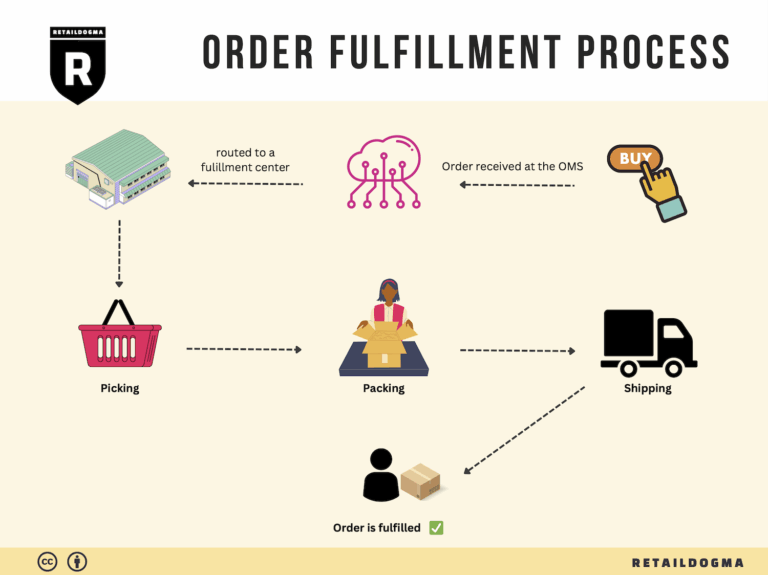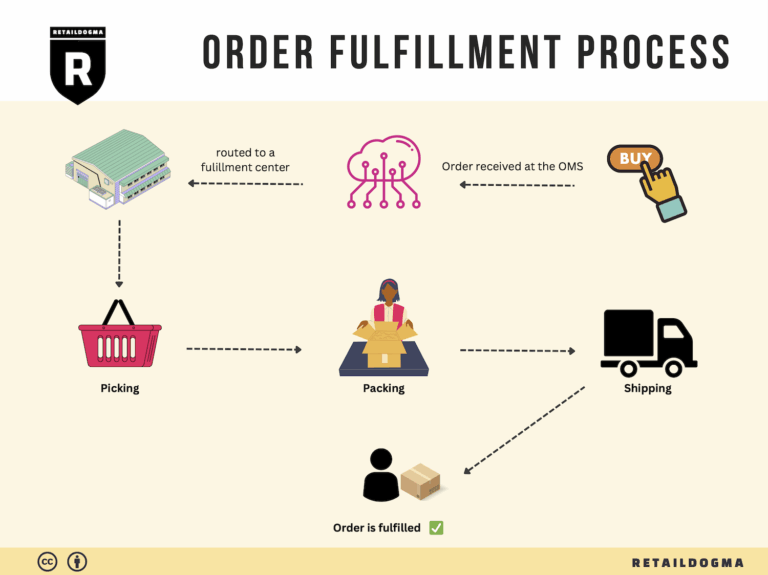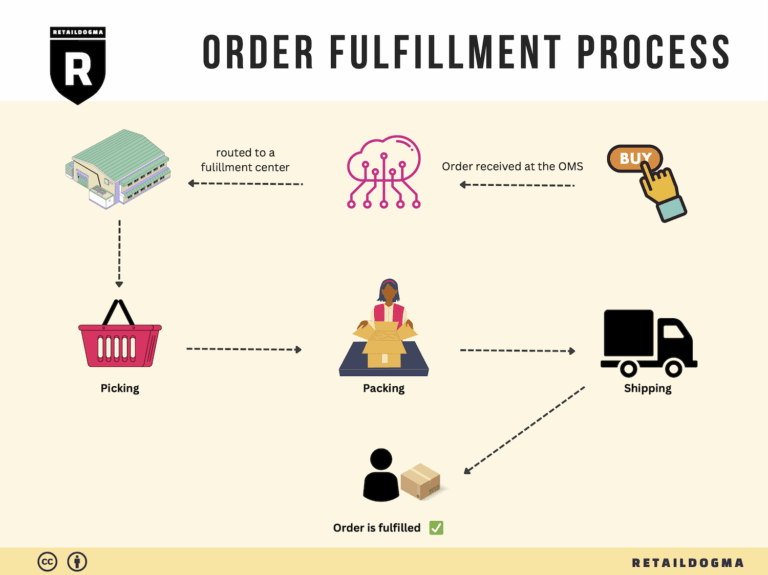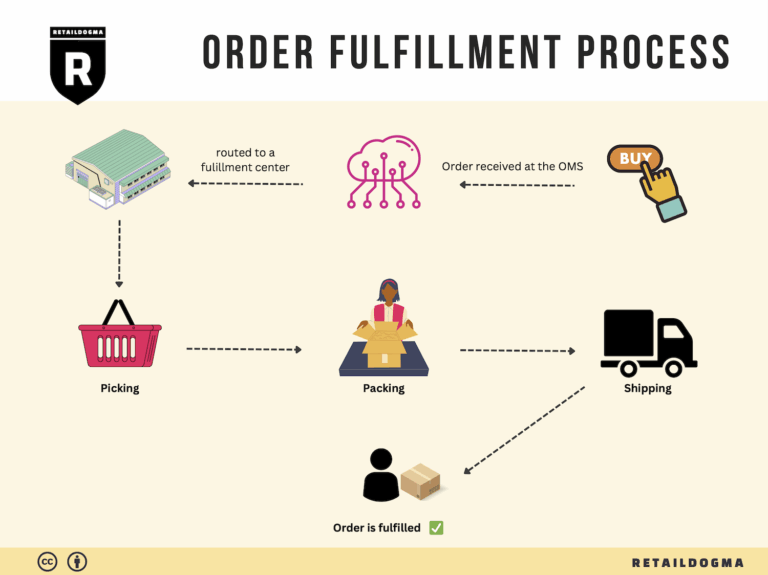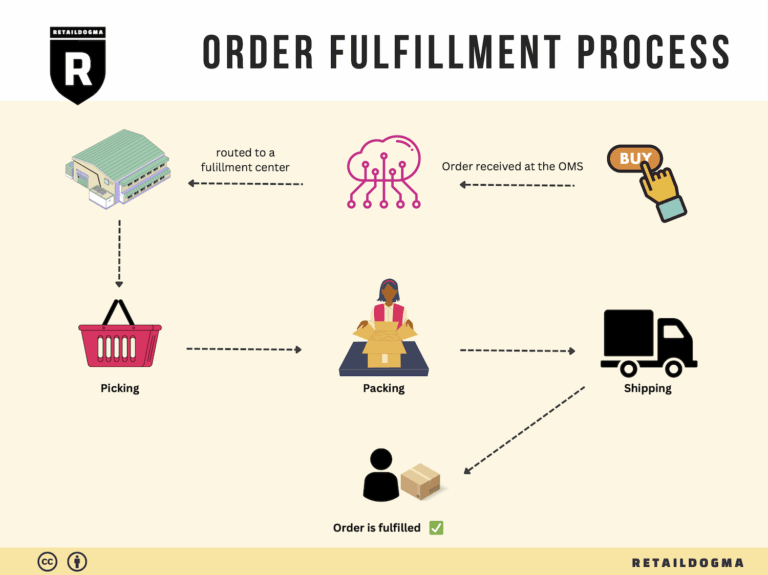Ecommerce Fulfillment Services: The Ultimate Guide (2025)
What is E-commerce Fulfillment? An Introduction for Growing Businesses
Understanding E-commerce Fulfillment
As an e-commerce business owner, you may find yourself grappling with one of the most critical challenges in your growth journey: managing the complexities of packing and shipping orders. The excitement of increasing sales can quickly turn into overwhelm when you realize that fulfilling those orders efficiently is essential to maintaining customer satisfaction and scaling your operations. Fulfillment, in its simplest form, is the process of getting a product from your inventory to your customer’s doorstep, encompassing everything from storage to packaging and shipping.
In this guide, we will explore the various aspects of e-commerce fulfillment that are crucial for growing businesses. We will start by discussing different fulfillment models, including Third-Party Logistics (3PL) and Fulfillment by Amazon (FBA). Understanding these models will help you determine which option aligns best with your business goals and operational needs.
Next, we will delve into the core services associated with e-commerce fulfillment. This includes inventory management, order processing, packing, shipping, and returns handling. Each of these services plays a vital role in ensuring that your customers receive their orders on time and in good condition, which is paramount for building loyalty and trust.
Choosing the right fulfillment partner can be daunting, but it is a decision that can significantly impact your business’s success. We will provide practical tips on how to evaluate potential partners, considering factors such as technology capabilities, scalability, and customer service. A well-chosen partner can streamline your operations, allowing you to focus on growing your business rather than getting bogged down in logistics.
Lastly, we will discuss pricing models and what you should expect to pay for fulfillment services. Understanding the cost structure of different fulfillment options will empower you to make informed financial decisions that align with your budget and profitability goals.
The ultimate aim of this guide is to empower you with the knowledge and tools necessary to make smart decisions about your logistics. By mastering the fulfillment process, you can enhance your operational efficiency, improve customer satisfaction, and position your e-commerce business for sustainable growth. Let’s dive in and explore how effective fulfillment can transform your business operations.
What You’ll Learn In This Guide
- What is E-commerce Fulfillment? An Introduction for Growing Businesses
- The Order Fulfillment Process: From ‘Buy’ Button to Customer’s Door
- Comparing Fulfillment Models: In-House vs. 3PL vs. Dropshipping
- A Deep Dive into Amazon FBA: Pros, Cons, and Who It’s For
- Core Services Offered by Fulfillment Centers
- How to Choose a Fulfillment Partner: A 6-Point Checklist
- Understanding Fulfillment Pricing: A Breakdown of Common Fees
- Frequently Asked Questions (FAQs) about Fulfillment
- Conclusion: Is Outsourcing Fulfillment the Right Move for Your Business?
- Important Disclaimer
The Order Fulfillment Process: From ‘Buy’ Button to Customer’s Door
1. Receiving Inventory
The order fulfillment process begins with receiving inventory. This step involves accepting shipments of products from suppliers or manufacturers. Once the delivery arrives at the fulfillment center, it is crucial to inspect the goods for accuracy and damage. This includes verifying the quantities against purchase orders and ensuring that the right products have been received.
This step is important because any discrepancies in inventory can lead to stockouts or excess inventory, both of which can impact customer satisfaction and operational efficiency. A key term associated with this step is SKU (Stock Keeping Unit). Each product is assigned a unique SKU that helps in tracking inventory levels, facilitating easier management, and ensuring that the right items are available for order fulfillment.
2. Warehouse Storage
After receiving inventory, the next step is warehouse storage. Here, products are sorted and placed into designated storage areas within the fulfillment center. Efficient storage is vital for ensuring that items can be retrieved quickly when orders come in. This involves using various storage solutions such as shelves, bins, and racks, which are organized based on product categories, sizes, and sales velocity.
The importance of this step lies in optimizing space and minimizing retrieval time. By strategically storing products, businesses can improve their pick rates and reduce the time it takes to fulfill orders. A related concept in this phase is ABC analysis, which categorizes inventory into three classes (A, B, C) based on their importance and demand frequency, allowing for more effective inventory management.
3. Order Picking
Once an order is placed by a customer, the fulfillment center moves to the order picking stage. This involves selecting the correct items from the warehouse based on the order details. Employees or automated systems use pick lists—documents that outline the items to be picked, their locations, and quantities—to ensure accuracy during this process.

Order picking is critical as it directly affects order accuracy and speed. Errors during this step can lead to incorrect shipments, resulting in returns and customer dissatisfaction. To enhance efficiency, many fulfillment centers utilize technologies like voice picking or handheld scanners, which help reduce picking errors and streamline the process.
4. Order Packing
After the items have been picked, they move to the order packing phase. Here, the selected products are carefully packaged to ensure they are secure during transit. This step involves choosing the right box or envelope, adding protective materials as needed, and generating shipping labels with tracking information.
The packing process is essential for maintaining product integrity and minimizing returns due to damage. It also plays a role in branding, as well-packaged orders can enhance the unboxing experience for customers. A key term in this phase is dimensional weight pricing, which affects shipping costs based on package dimensions rather than just weight, encouraging businesses to optimize packaging sizes.
5. Shipping & Delivery
The final step in the order fulfillment process is shipping and delivery. Once the orders are packed, they are handed over to shipping carriers for delivery to the customer. This step involves selecting the appropriate shipping method based on factors like cost, speed, and destination, as well as generating tracking information for customer visibility.
Shipping and delivery are crucial for customer satisfaction, as timely delivery can significantly impact the overall shopping experience. Businesses often use last-mile delivery solutions to ensure that packages reach customers as quickly and efficiently as possible. This term refers to the final leg of the delivery journey, which can be one of the most challenging and costly parts of the shipping process.
Conclusion
Understanding and optimizing each step of the order fulfillment process is essential for e-commerce businesses looking to scale. By focusing on receiving inventory, warehouse storage, order picking, order packing, and shipping & delivery, companies can enhance their operational efficiency, improve customer satisfaction, and ultimately drive sales growth. Implementing best practices and leveraging technology at each stage can lead to significant improvements in the overall fulfillment strategy.
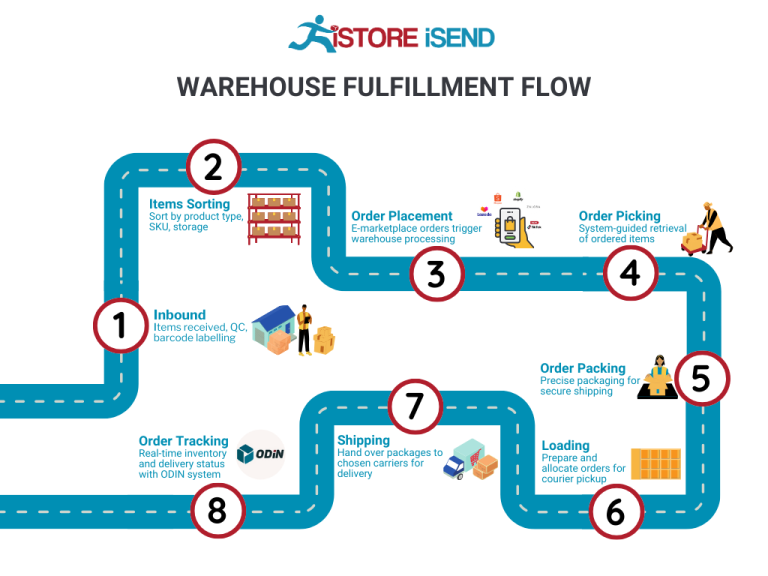
Comparing Fulfillment Models: In-House vs. 3PL vs. Dropshipping
Fulfillment Model Comparison
| Model | Who Handles Inventory | Best For (Business Stage) | Key Advantage | Key Disadvantage |
|---|---|---|---|---|
| In-House Fulfillment | The business itself | Established businesses | Greater control over operations and quality | High overhead costs and resource-intensive |
| Third-Party Logistics (3PL) | A third-party provider | Scaling businesses | Access to expertise and infrastructure | Less control over inventory and processes |
| Dropshipping | Supplier | Startups and small brands | Low upfront costs and inventory risk | Lower profit margins and reliance on suppliers |
In-House Fulfillment
In-house fulfillment refers to a model where a business manages its inventory and shipping operations within its own facilities. This model is typically suited for established businesses that have the resources and infrastructure to handle warehousing, picking, packing, and shipping. The key advantage of in-house fulfillment is the level of control it offers over operations. Businesses can implement their quality standards, manage inventory more efficiently, and create a tailored customer experience. Furthermore, having an in-house team allows for immediate responses to issues, fostering a more agile operation.
However, this model comes with significant disadvantages. The most notable is the high overhead cost associated with maintaining a fulfillment center, which includes staffing, warehousing, equipment, and technology investments. Additionally, managing fulfillment in-house can be resource-intensive, requiring time and expertise that might otherwise be spent on core business activities like marketing and product development. For many businesses, especially those looking to scale quickly, the in-house model may not be sustainable long-term.
Third-Party Logistics (3PL)
Third-party logistics (3PL) providers offer a solution where businesses outsource their fulfillment operations to specialized companies. This model is ideal for businesses in the scaling stage, as it allows them to leverage the expertise and infrastructure of established logistics providers. 3PL companies manage inventory, warehousing, order processing, and shipping, enabling businesses to focus on their core competencies while improving operational efficiency.
The primary advantage of using a 3PL provider is access to advanced logistics capabilities and technology that may be cost-prohibitive for smaller businesses to develop in-house. This includes sophisticated inventory management systems, shipping optimization software, and robust distribution networks. However, the downside is that businesses lose some control over their inventory and fulfillment processes. This can lead to challenges in maintaining product quality, managing shipping times, and ensuring a consistent customer experience. Additionally, relying on a third party may introduce complexities in communication and coordination, which can affect operational efficiency.
Dropshipping
Dropshipping is a fulfillment model where a business sells products without holding any inventory. Instead, when a customer places an order, the business purchases the item from a third-party supplier who then ships it directly to the customer. This model is particularly suitable for startups and small brands looking to enter the market with minimal upfront investment and risk.
The key advantage of dropshipping is the low barrier to entry, as businesses do not need to invest in inventory upfront. This significantly reduces financial risk, allowing entrepreneurs to test new products and market demand without significant capital expenditure. However, dropshipping has its drawbacks, including lower profit margins due to reliance on suppliers and potential quality control issues. Businesses are also dependent on their suppliers for inventory management and shipping, which can lead to delays and inconsistencies that negatively impact customer satisfaction. Furthermore, the lack of direct control over the fulfillment process can make it challenging to build a strong brand identity.
Conclusion
Choosing the right fulfillment model depends on several factors, including business size, growth stage, and operational priorities. In-house fulfillment offers control but requires significant investment, while 3PL provides expertise and scalability at the cost of some control. Dropshipping minimizes risk and investment but can lead to lower margins and quality concerns. Understanding these models helps e-commerce business owners make informed decisions that align with their strategic goals and operational capabilities.
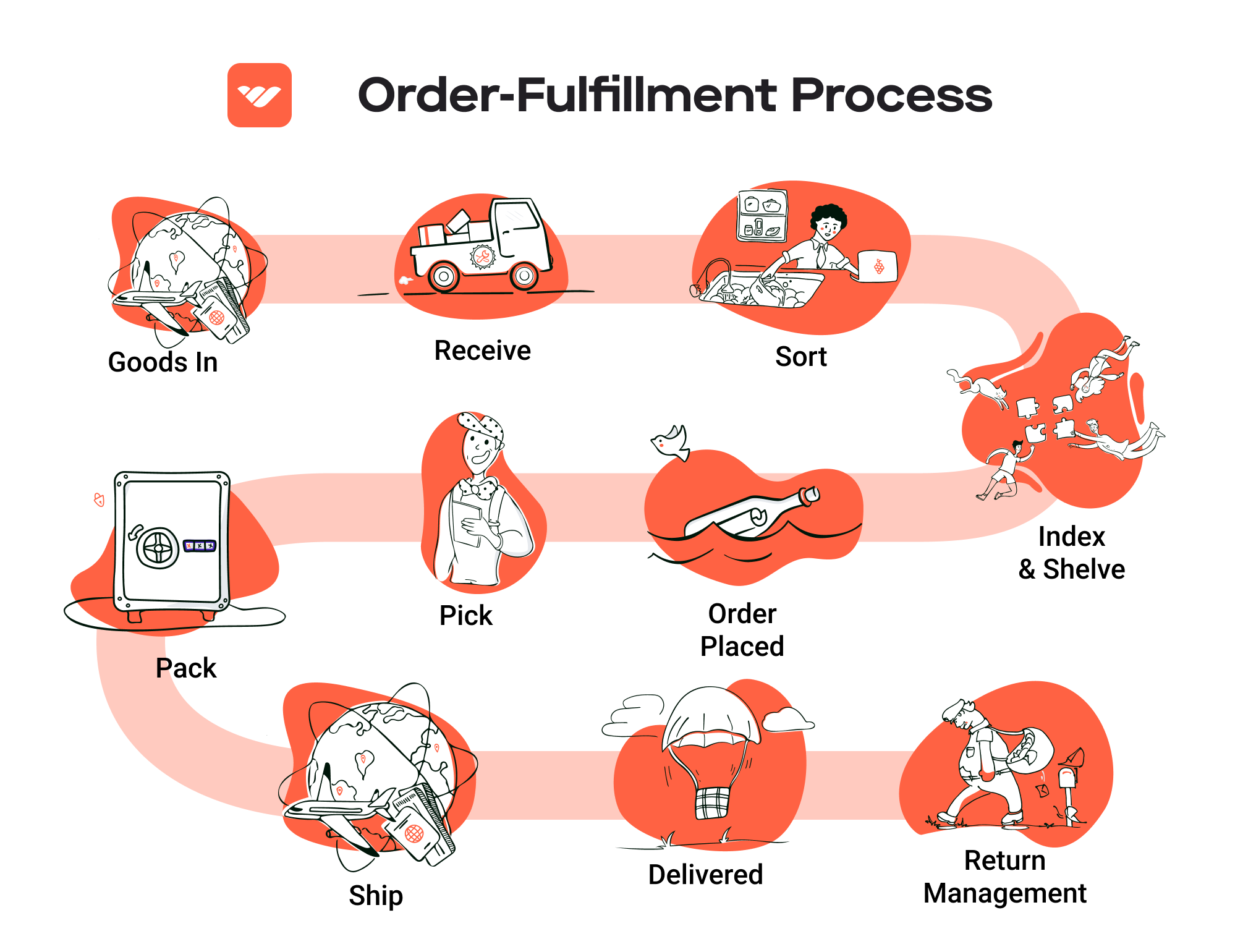
A Deep Dive into Amazon FBA: Pros, Cons, and Who It’s For
Understanding Fulfillment by Amazon (FBA)
Fulfillment by Amazon (FBA) is a service that allows e-commerce sellers to store their products in Amazon’s fulfillment centers, where Amazon takes care of storage, packaging, and shipping. This model not only simplifies logistics for sellers but also enables them to leverage Amazon’s vast distribution network and customer service capabilities.
How FBA Works
When a seller opts for FBA, they send their products to Amazon’s fulfillment centers. Once received, Amazon handles the entire order process. Here’s a step-by-step overview of how FBA operates:
- Product Setup: Sellers create product listings on Amazon and choose FBA as the fulfillment method.
- Inventory Shipment: Sellers ship their products to Amazon’s fulfillment centers. They can send products to one or multiple locations, depending on Amazon’s distribution strategy.
- Storage and Management: Amazon stores the products in its warehouses. The company uses advanced technology and software to manage inventory, ensuring that stock levels are maintained and orders can be fulfilled quickly.
- Order Processing: When a customer places an order, Amazon picks, packs, and ships the product on behalf of the seller. This process is typically very fast, often resulting in same-day or next-day delivery.
- Customer Service: Amazon also handles customer service inquiries and returns for FBA orders, allowing sellers to focus on their business without worrying about logistics.
- Fees: Sellers pay fees for storage and fulfillment services, which can vary based on product size and time of year.
Pros of Using FBA
1. Prime Eligibility
One of the most significant advantages of FBA is that it makes products eligible for Amazon Prime. Prime members often prefer products that are eligible for fast, free shipping. This can lead to higher conversion rates and increased sales, as many customers filter their searches to show only Prime-eligible items.
2. Customer Trust
Products fulfilled by Amazon benefit from the trust and credibility associated with the Amazon brand. Customers are more likely to purchase items backed by Amazon’s reputation for reliable shipping and customer service. This trust can lead to increased sales and lower return rates.
3. Multi-Channel Fulfillment
FBA is not limited to sales on Amazon. Sellers can use FBA to fulfill orders from other sales channels, such as their own websites or other marketplaces. This multi-channel fulfillment capability enables businesses to centralize their logistics operations while reaching a broader audience.
4. Scalability
Using FBA allows sellers to scale their businesses without the need to invest heavily in warehousing or logistics infrastructure. As demand grows, sellers can quickly send more inventory to Amazon, allowing them to focus on marketing and product development.
5. Time Savings
With Amazon handling storage, packing, and shipping, sellers can save significant time and resources that would otherwise be spent on logistics management. This allows them to concentrate on core business activities, such as product sourcing and customer engagement.
Cons of Using FBA
1. High Fees
While FBA offers many benefits, it comes at a cost. Sellers incur various fees, including storage fees for inventory stored in Amazon’s warehouses and fulfillment fees based on the size and weight of products. These fees can quickly add up, impacting profit margins, especially for low-cost items.
2. Strict Inventory Rules
Amazon has stringent inventory management policies that sellers must adhere to. This includes requirements for labeling, packaging, and maintaining stock levels. Failure to comply with these rules can lead to additional fees or penalties, which can complicate operations for sellers.
3. Commingling Risks
FBA uses a commingling model, which means that inventory from different sellers is stored together. While this can streamline fulfillment, it also poses risks. If a customer receives a defective or counterfeit item, it can reflect poorly on the seller’s account, even if the issue originated from another seller’s inventory.
4. Loss of Control
By using FBA, sellers relinquish a degree of control over their inventory and order fulfillment. Issues such as delays in shipping, stockouts, or mismanagement can occur, and sellers may have limited recourse to resolve these problems quickly.
5. Limited Branding Opportunities
FBA products often come in generic Amazon packaging, which can limit branding opportunities for sellers. This may reduce the ability to create a unique unboxing experience that enhances brand loyalty and customer engagement.
Who is FBA Best For?
Fulfillment by Amazon is particularly well-suited for:
- Small to Medium-Sized Businesses: Businesses looking to scale quickly without investing heavily in logistics infrastructure can benefit from FBA.
- Sellers with High Volume: Those who sell products that move quickly and have a high turnover rate can maximize the benefits of FBA while managing costs effectively.
- E-commerce Entrepreneurs: New sellers or entrepreneurs who want to leverage Amazon’s customer base and brand trust can gain traction more rapidly using FBA.
- Multi-Channel Sellers: Businesses that sell across various platforms can benefit from FBA’s multi-channel fulfillment capabilities, streamlining their logistics processes.
In conclusion, while FBA offers numerous advantages for e-commerce sellers, it is essential to weigh these against the potential drawbacks. Understanding how FBA aligns with your business goals and operational capacity will help you make an informed decision about whether to integrate this fulfillment model into your strategy.
Core Services Offered by Fulfillment Centers
Inventory Management & Warehousing
Inventory management and warehousing are foundational services provided by fulfillment centers, crucial for the efficiency of any e-commerce operation. This service encompasses the systematic tracking of products from the moment they arrive at the warehouse until they are shipped to customers. Fulfillment centers utilize advanced software to manage inventory levels, ensuring that stock is optimally maintained to meet customer demand without overstocking.
Benefits:
1. Real-time Visibility: E-commerce businesses gain access to real-time data about inventory levels, enabling them to make informed decisions about reordering and stock management.
2. Reduced Holding Costs: By effectively managing inventory, businesses can minimize storage costs associated with excess stock and reduce the risk of obsolescence.
3. Enhanced Order Fulfillment: Accurate inventory management leads to faster order processing, which is vital for maintaining customer satisfaction and loyalty. This is particularly important in today’s market, where customers expect rapid delivery.
Pick and Pack Services
Pick and pack services are integral to the fulfillment process, where items are selected from the warehouse and packaged for shipment. Fulfillment centers employ a combination of human labor and automation to streamline this process. In a typical scenario, once an order is placed, the fulfillment center staff retrieves the items from designated storage areas and carefully packages them for delivery.
Benefits:
1. Efficiency and Speed: Automation, such as conveyor belts and robotic systems, significantly reduces the time required to pick and pack orders. This efficiency allows businesses to meet tight delivery windows and enhances overall operational productivity.
2. Accuracy: With sophisticated technology and trained personnel, fulfillment centers can minimize picking errors, ensuring that customers receive the correct items. This accuracy is essential for maintaining a good reputation and reducing return rates.
3. Customization: Fulfillment centers can accommodate various packing requirements, from standard boxes to custom packaging solutions. This flexibility allows businesses to enhance their brand image through personalized packaging experiences.
Kitting and Assembly
Kitting and assembly services involve the grouping of various products into a single package or the assembly of products before shipping. This service is particularly beneficial for businesses that sell bundled items or products that require some level of assembly prior to delivery. Fulfillment centers can manage the entire kitting process, from sourcing components to assembling them into final products.
Benefits:
1. Streamlined Operations: By outsourcing kitting and assembly, e-commerce businesses can focus on core activities like marketing and sales, while leaving the logistical complexities to the fulfillment center.
2. Cost Efficiency: Consolidating multiple items into a single kit can reduce shipping costs and improve margins. Fulfillment centers can efficiently handle bulk shipments, which often translates to savings for the business.
3. Improved Customer Experience: Offering kits or assembled products can enhance customer satisfaction, as it simplifies the purchasing process. Customers appreciate the convenience of receiving a complete solution rather than multiple separate items.
Returns Management (Reverse Logistics)
Returns management, or reverse logistics, is a critical service that ensures the efficient handling of returned products. Fulfillment centers implement streamlined processes for managing returns, which include inspecting returned items, restocking, and facilitating refunds or exchanges. Given the rise of online shopping, effective returns management is essential for maintaining customer trust and satisfaction.
Benefits:
1. Customer Retention: A hassle-free returns process significantly enhances customer loyalty. When customers feel secure in their ability to return products, they are more likely to make purchases, knowing that their satisfaction is prioritized.
2. Operational Efficiency: Fulfillment centers have the infrastructure to handle returns swiftly, allowing businesses to restock and resell returned items without delay. This efficiency minimizes losses associated with returned merchandise.
3. Data Insights: Analyzing return data can provide valuable insights into customer preferences and product performance. Understanding the reasons behind returns helps businesses make informed decisions regarding product offerings and quality improvements.
In conclusion, partnering with a fulfillment center provides e-commerce businesses with a range of core services that enhance operational efficiency, improve customer experience, and ultimately support scalable growth. By leveraging these services, businesses can focus on their strategic goals while ensuring that logistics and fulfillment processes are managed effectively.
How to Choose a Fulfillment Partner: A 6-Point Checklist
Location & Warehouse Network
Importance: The geographical location of a fulfillment partner’s warehouses directly impacts shipping times and costs. Choosing a partner with warehouses strategically located near your customer base can significantly enhance delivery speed and reduce shipping expenses.
Questions to Ask:
– Where are your warehouses located, and how do those locations align with my target market?
– What is your average shipping time to key markets?
– How do you handle shipping to international customers, if applicable?
Technology & Integrations
Importance: In today’s e-commerce landscape, efficient order processing and inventory management are crucial. A partner that utilizes advanced technology and offers seamless integrations with your existing systems can streamline operations, improve accuracy, and enhance customer experience.
Questions to Ask:
– What warehouse management system (WMS) do you use, and what are its key features?
– Can your systems integrate with my e-commerce platform (e.g., Shopify, WooCommerce, Amazon)?
– How do you ensure real-time inventory tracking and order updates?
Specializations (e.g., Cold Storage, Oversized Items)
Importance: Depending on your product offerings, you may require specialized storage solutions. For example, if you sell perishable goods, a partner with cold storage capabilities will be essential. Understanding the partner’s specializations can prevent logistical challenges and ensure your products are stored and handled correctly.
Questions to Ask:
– Do you have any specializations, such as handling fragile items or temperature-sensitive goods?
– What certifications do you hold that demonstrate your capability in these areas?
– How do you manage inventory for specialized items, and what processes are in place to ensure their safety?
Scalability & Capacity
Importance: As your business grows, your fulfillment needs will evolve. Partnering with a fulfillment center that can scale with your business ensures that you can meet increasing demand without interruption. It’s essential to understand the partner’s capacity to handle fluctuations in order volume.
Questions to Ask:
– What is your current capacity, and how do you manage peak seasons or unexpected demand spikes?
– Can you accommodate seasonal growth, and what is your plan for scaling operations?
– Are there additional costs associated with scaling up my operations?
Pricing and Contracts
Importance: Understanding the pricing structure and contract terms is vital for managing your budget and ensuring transparency in your partnership. A clear pricing model helps you forecast costs and avoid unexpected fees that can impact your profit margins.
Questions to Ask:
– What is your pricing model (e.g., per order, per item, or monthly fee)?
– Are there any additional fees for services such as returns processing, storage, or packaging?
– What are the terms of your contracts, and what is the process for terminating or renegotiating the agreement?
Customer Support & Reviews
Importance: A responsive and knowledgeable customer support team can be a game-changer in resolving issues quickly and efficiently. Additionally, researching customer reviews provides insights into the partner’s reliability, service quality, and overall satisfaction.
Questions to Ask:
– What support channels do you offer (e.g., phone, email, chat), and what are your support hours?
– How do you handle issues or discrepancies in order fulfillment?
– Can you provide references or testimonials from current clients?
Conclusion
Choosing the right fulfillment partner is a critical decision that can significantly impact your business’s efficiency and customer satisfaction. By using this checklist, you can systematically evaluate potential partners to ensure they align with your operational needs and growth objectives. Always remember that a successful partnership is built on clear communication, mutual understanding, and a shared commitment to customer service excellence.
Understanding Fulfillment Pricing: A Breakdown of Common Fees
Initial Setup Fees
Initial setup fees are often incurred when you first begin using a fulfillment service. These fees cover the costs associated with integrating your business with the fulfillment center’s system. This may include software integration, account setup, and any necessary training. The fee structure can vary widely based on the fulfillment provider, but it’s typically a one-time charge.
To calculate these fees, fulfillment centers may consider the complexity of your product catalog, the number of SKUs you have, and the level of customization required for the integration. For instance, a business with a simple product range may face lower fees compared to a company with a diverse inventory that requires extensive customization.
Receiving Fees
Receiving fees are charged for the process of accepting and logging your inventory into the fulfillment center. When your products arrive, the fulfillment center must inspect, sort, and store them, which requires labor and resources.
These fees are generally calculated per unit or per pallet received. For example, if you send a shipment of 100 units, and the receiving fee is $0.50 per unit, your total receiving fee would be $50. It’s important to note that additional charges may apply if your products require special handling or if the shipment is not properly labeled.
Storage Fees (per pallet/bin)
Storage fees are incurred for keeping your inventory in the fulfillment center. These fees are typically charged on a monthly basis and are calculated based on the space your products occupy, often measured in pallets or bins.
For example, if the storage fee is $20 per pallet per month and you have 5 pallets, your monthly storage cost would be $100. Some fulfillment centers offer tiered pricing, where the fee decreases as you store more pallets, providing an incentive for larger inventory levels. Additionally, be aware that some providers may charge for long-term storage if your inventory remains unsold beyond a specified period, which can significantly impact your costs.
Pick & Pack Fees (per item/order)
Pick and pack fees are charged for the labor involved in picking items from storage and packing them for shipment. This fee can be calculated on a per-item or per-order basis.
For instance, if the fee is $1.00 per item and a customer orders three items, the pick and pack fee for that order would be $3.00. Alternatively, if a flat fee of $2.50 is charged per order, regardless of the number of items, your total cost would be $2.50 per order. Understanding how your fulfillment provider calculates these fees can help you strategize your product bundling or order fulfillment methods to minimize costs.
Shipping Fees
Shipping fees are among the most variable costs in fulfillment pricing. These fees depend on multiple factors, including the weight and dimensions of the package, the shipping method chosen (e.g., standard, expedited), and the destination of the shipment.
Fulfillment centers may partner with various carriers (e.g., UPS, FedEx, USPS) and negotiate shipping rates, which can lead to different costs based on the service level selected. For example, shipping a 2-pound package to a nearby state might cost $5.00 via ground shipping, while the same package sent overnight could cost $20.00.
To calculate your shipping costs accurately, consider using the fulfillment center’s shipping calculator, which typically factors in package weight, dimensions, and destination zip code.
Tips for Getting an Accurate Quote
-
Provide Detailed Information: When seeking quotes, offer detailed information about your products, including dimensions, weight, and any special handling requirements. This helps fulfillment centers provide you with precise estimates.
-
Understand Fee Structures: Familiarize yourself with the fee structures of different fulfillment centers. Some may offer flat-rate pricing, while others charge based on various metrics. Understanding these nuances can help you compare quotes effectively.
-
Consider Volume Discounts: Inquire about volume discounts, especially if you plan to scale your operations. Many fulfillment centers offer reduced rates for businesses that commit to larger shipping volumes.
-
Negotiate Terms: Don’t hesitate to negotiate terms with fulfillment providers. Discussing your expected order volume and service level requirements may lead to more favorable pricing.
-
Request a Breakdown of Fees: Always ask for a detailed breakdown of all potential fees. This will help you understand the cost structure and avoid any surprise charges down the line.
By being informed and proactive, you can navigate fulfillment pricing effectively, ensuring that you choose a provider that aligns with your business goals while keeping costs manageable.
Frequently Asked Questions (FAQs) about Fulfillment
1. What is the TYS1 Amazon Fulfillment Center?
The TYS1 fulfillment center, located in Alcoa, Tennessee, is one of Amazon’s advanced logistics facilities that operates 24/7. It is designed to process a high volume of packages, utilizing both human labor and robotics to enhance efficiency. The center can handle up to 650,000 packages daily, serving as a key part of Amazon’s “first mile” network, which is crucial for getting products from the warehouse to the customer.
2. How does the TYS1 facility utilize robotics?
The TYS1 center employs advanced robotics to streamline operations, reduce manual labor, and minimize the risk of injuries among workers. Robots assist in picking, packing, and sorting items, which allows human associates to focus on more complex tasks and maintain a high throughput of orders.
3. What types of products are processed at TYS1?
The TYS1 fulfillment center handles a wide variety of items, including small consumer goods such as toiletries, food products, and household items. The facility is optimized for products that fit within a certain size range, specifically items that are up to 18 inches in dimension.
4. How does the fulfillment process work at TYS1?
When an order is placed on Amazon, the items are picked from the inventory stored in the TYS1 center. They are placed into totes, which are then transported via conveyor belts to packing stations. Once packed, the orders are prepared for shipping to sort centers or directly to delivery services.
5. What is the difference between a warehouse and a fulfillment center?
A warehouse is primarily used for storing goods, while a fulfillment center is focused on processing and shipping orders directly to customers. Fulfillment centers are equipped with more advanced technology and systems to manage inventory and expedite the order fulfillment process, which is crucial for e-commerce operations.
6. What are the benefits of using Amazon’s fulfillment services?
Using Amazon’s fulfillment services allows businesses to leverage Amazon’s extensive logistics network, ensuring faster shipping times and access to a larger customer base. Additionally, businesses can benefit from streamlined inventory management, reduced operational costs, and enhanced customer satisfaction through reliable order fulfillment.
7. How much do fulfillment services cost?
Fulfillment service costs can vary based on several factors, including the volume of orders, the type of products being stored and shipped, and the specific services required (e.g., packing, handling, storage). Typically, fees include storage fees per cubic foot and fulfillment fees per order, which can range from a few dollars to higher amounts depending on the complexity and size of the items.
8. What is a 3PL (Third-Party Logistics)?
A 3PL, or third-party logistics provider, is a service that allows businesses to outsource their logistics and fulfillment operations. This can include warehousing, inventory management, order fulfillment, and shipping. Using a 3PL can help businesses focus on core activities while benefiting from the expertise and resources of logistics specialists.
9. How can businesses benefit from the TYS1 fulfillment center?
Businesses can benefit from the TYS1 center by improving their order fulfillment speed and efficiency. By utilizing Amazon’s infrastructure, businesses can ensure that their products are processed quickly and shipped to customers in a timely manner, ultimately enhancing customer satisfaction and retention.
10. What employment opportunities are available at the TYS1 fulfillment center?
The TYS1 fulfillment center offers a variety of employment opportunities, ranging from warehouse associates to managerial positions. Starting pay is competitive, with benefits available from day one, including health insurance and tuition reimbursement programs after 90 days. Opportunities for advancement are also available as the facility continues to grow.
Conclusion: Is Outsourcing Fulfillment the Right Move for Your Business?
Evaluating the Benefits of Outsourcing Fulfillment
Outsourcing your fulfillment operations can be a transformative move for your e-commerce business. By partnering with a specialized fulfillment service, you can save significant time and resources that would otherwise be spent on managing logistics. This allows you to focus on what you do best—growing your brand and serving your customers. With the ability to streamline operations, fulfillment partners can help ensure that your orders are processed efficiently and accurately, enhancing customer satisfaction.
Scalability is another crucial advantage of using a fulfillment service. As your business grows, demand can fluctuate dramatically. A robust fulfillment partner can adapt to these changes, providing the necessary infrastructure to handle increased order volumes without the strain of hiring and training additional staff or investing in warehouse space. This flexibility is especially beneficial during peak seasons or promotional events, allowing you to scale operations up or down based on real-time needs.
Moreover, fulfillment centers bring expertise that can significantly enhance your operational efficiency. With advanced technology, such as robotics and inventory management software, they can optimize the picking, packing, and shipping processes, reducing the likelihood of errors and delays. This expertise not only improves your service levels but also provides insights and data that can inform your future business decisions.
However, the success of outsourcing fulfillment hinges on choosing the right partner. Conducting thorough due diligence is essential to ensure that your chosen provider aligns with your business goals, values, and customer expectations.
Call to Action
To determine if outsourcing fulfillment is the right next step for your business, take the time to audit your current shipping processes. Assess your capacity to handle order volumes, the efficiency of your logistics, and your overall customer satisfaction levels. This evaluation will provide clarity on whether a fulfillment partner can help you achieve your growth objectives. Start today, and position your business for scalable success.
Important Disclaimer
⚠️ Important Disclaimer
The information in this guide is for educational purposes. Fulfillment services, pricing, and platform features change frequently. Always conduct your own due diligence and consult with providers directly before making business decisions.

